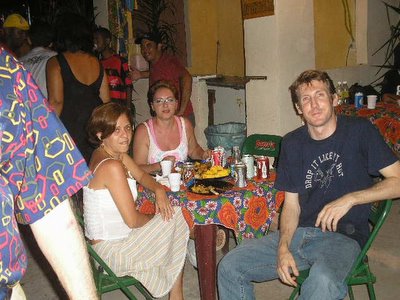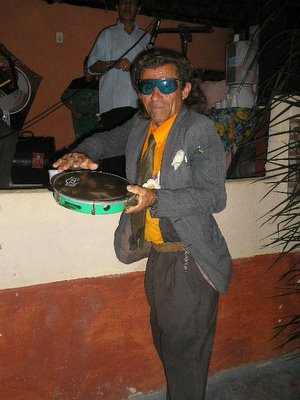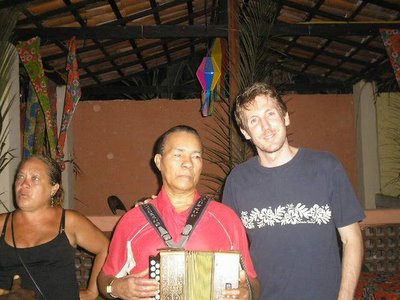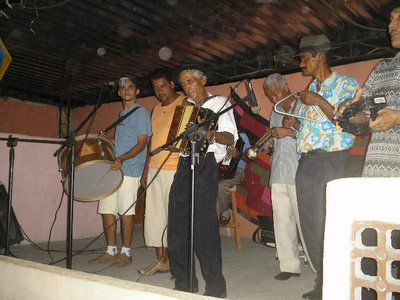Forró de Arlindo
So, yesterday I went to the Forró night of Arlindo dos Oito Baixos. I met my contact, Roberto outside a shopping mall in the Boa Vista neighborhood of Recife and he called up his friend who drives a cab and we got picked up within 10 minutes.
So, we made it to the forró which is located in a working class neighborhood called Dois Unidos. As we made our way down the narrow street filled with bars that were croweded with Sunday afternoon drinkers the cab driver commented "the poorer the neighborhood the more parties there are" , something that I had heard before and noticed from my time living in Salvador. We hopped out the cab and I was introduced to the group of people out front. The forró actually takes place in the backyard of Arlindo's house that is quite large, probably 10 meters by 60. The whole yard is topped by a tall, sloping metal roof and at the far end is a concrete stage about a meter off the ground. The area is set up to look like the typical main street of an interior town and is quite charming with its little concrete "buildings" that immitate stores where you can buy drinks, candies, forró cd's, and food. We ordered some carne do sol with farofa and fritas (dried meat, manioc flour with butter, and fried potatos), a common plate in the Northeast. Washed down with a couple cold Antartica beers, it was delicious!
I was introduced to more people than I can remember including Arlindo, the master of ceremonies. Arlindo plays the samfona de oito baixos or the eight bass accordeon, which is the "traditional" lead instrument of forró pé de serra. It is very rare to see it played in Brazil these days as most of the players have switched to the larger accordeon with a much larger number of keys. The oito baixos is unique in Brazil as it is tuned to be chromatic, where in Europe it is normally diatonic. There is a button on one side that allows the samfona to be opened or closed without making a sound. It is also unique in that one note is made when opening it and another is played when closing the instrument. According to Arlindo this fact renders technique of playing the samfona de oito baixos completely different. He also plays the larger accordeon, but normally plays the oito baixos because he feels that it is in danger of dissapearing and he wants to keep the tradition alive. He started playing when he was 10 years old taking after his father who at first resisted his playing prefering his son not to be a musician. He eventually relented and Arlindo took off on his musical career.
There were various forró bands playing from the time we arrived, but when Alindo took the stage later in the night I understood why he was so famous. His playing really stood out as exceptional and you could see the joy on his face as he animated the crowd. The audience consisted of mostly locals who knew each other. Several of the people that I spoke with said they knew just about everyone in attendence by name and it appeared that only myself and a small group from Portugal that knew a local woman were the only people not from Recife or the immediate vicenity. There were alot of children and couples and the whole scene really was a family atmosphere, kids dancing with their aunts, uncles, and parents. There were also a large amount of musicians in attendence as about half the people I was introduced to over the evening also played either accordeon or one of the percussion instruments used in forró.
In my conversation with Arlindo he noted that forró had become more popular in the past few years with alot of younger people becoming interested in the music. He said that for a long time forró seemed to be becoming less popular and that he was very pleased to see a new interest in the music. He couldn't exactly explain why he thought this might be, but attributed a few musicians of the area with helping it happen.
Another interesting comment came from a woman who attends Arlindo's forrós regularly. When I mentioned my experiences with forró in Brasilia and São Paulo she observed that "The Northeast and its culture is not a physical space. It is a state of mind and so it moves freely and doesn't just remain in one fixed place. All of the migration that has happened from the Northeast to the South of Brazil has helped this to happen."
So, I could go on about alot more of my observations from the night but I'll cut it here as I have an appointment to go to a local radio station and interview the host of a forró program.
So far the forró at Arlindo's is the best forró I have heard musically speaking in Brazil and the atmosphere was great. I returned home tired and sweaty after several hours of dancing with some talented partners and some great conversations about music and life here...
 Taking a break from dancing.
Taking a break from dancing. Rock the pandeiro bro! (But Miles Davis wants his glasses back).
Rock the pandeiro bro! (But Miles Davis wants his glasses back). Forrozeiros with my contact Roberto Andrade from the Confraria do Forró Pernambucana.
Forrozeiros with my contact Roberto Andrade from the Confraria do Forró Pernambucana. Arlindo and zabumba palyer.
Arlindo and zabumba palyer. You gotta dance!
You gotta dance! 





